
The EMD BL2 is a model of diesel-electric locomotive built by General Motors Electro-Motive Division (EMD). A total of 58 units were built between 1947 and 1949. The BL2 was not very successful, as it was unreliable and occupied a gap between carbody and hood units, which resulted in it suffering from the drawbacks of both designs. However, lessons learned from the BL2 were incorporated into EMD's next design, the GP7.
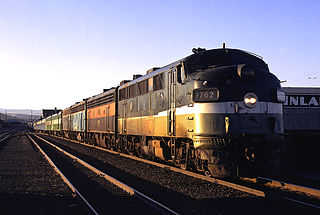
The EMD F3 is a 1,500-horsepower (1,100 kW) B-B freight- and passenger-hauling carbody diesel locomotive produced between July 1945 and February 1949 by General Motors’ Electro-Motive Division. Final assembly was at GM-EMD's La Grange, Illinois plant. A total of 1,111 cab-equipped lead A units and 696 cabless booster B units were built.
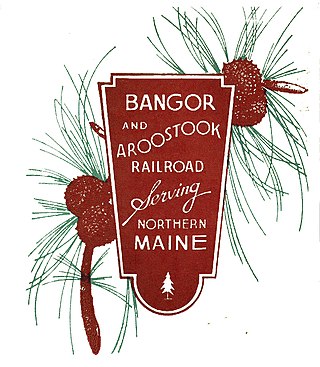
The Bangor and Aroostook Railroad was a United States railroad company that brought rail service to Aroostook County in northern Maine. Brightly-painted BAR boxcars attracted national attention in the 1950s. First-generation diesel locomotives operated on BAR until they were museum pieces. The economic downturn of the 1980s, coupled with the departure of heavy industry from northern Maine, forced the railroad to seek a buyer and end operations in 2003. It was succeeded by the Montreal, Maine and Atlantic Railway.
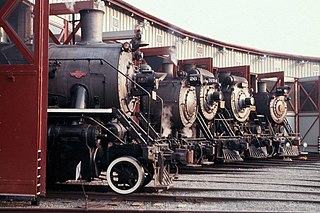
Steamtown National Historic Site (NHS) is a railroad museum and heritage railroad located on 62.48 acres (25.3 ha) in downtown Scranton, Pennsylvania, at the site of the former Scranton yards of the Delaware, Lackawanna and Western Railroad (DL&W). The museum is built around a working turntable and a roundhouse that are largely replications of the original DL&W facilities; the roundhouse, for example, was reconstructed from remnants of a 1932 structure. The site also features several original outbuildings dated between 1899 and 1902. All the buildings on the site are listed with the National Register of Historic Places as part of the Delaware, Lackawanna and Western Railroad Yard-Dickson Manufacturing Co. Site.
The Wilmington and Western Railroad is a freight and heritage railroad in northern Delaware, operating over a former Baltimore and Ohio Railroad (B&O) branch line between Wilmington and Hockessin. The 10.2-mile (16.4 km) railroad operates both steam and diesel locomotives. It was added to the National Register of Historic Places as a national historic district in 1980. Wilmington & Western serves one customer for revenue service, and interchanges with CSX Transportation at Landenberg Junction, Delaware
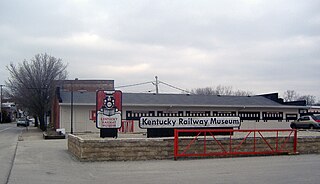
The Kentucky Railway Museum, now located in New Haven, Kentucky, United States, is a non-profit railroad museum dedicated to educating the public regarding the history and heritage of Kentucky's railroads and the people who built them. Originally created in 1954 in Louisville, Kentucky, the museum is at its third location, in extreme southern Nelson County. It is one of the oldest railroad stations in the United States.

The Katahdin Iron Works is a Maine state historic site located in the unorganized township of the same name. It is the site of an ironworks which operated from 1845 to 1890. In addition to the kilns of the ironworks, the community was served by a railroad and had a 100-room hotel. The site was listed on the National Register of Historic Places in 1969.

The Georgia State Railroad Museum is a museum in Savannah, Georgia located at a historic Central of Georgia Railway site. It includes parts of the Central of Georgia Railway: Savannah Shops and Terminal Facilities National Historic Landmark District. The complex is considered the most complete antebellum railroad complex in the United States. The museum, located at 655 Louisville Road, is part of a historic district included in the National Register of Historic Places.
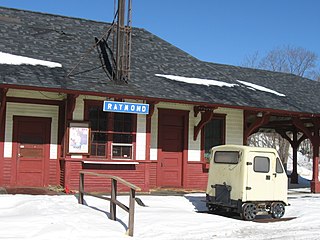
The Raymond Railroad Depot is a historic former Boston and Maine railroad station at 1 Depot Street in the center of Raymond, New Hampshire. Built in 1893, it is one of the state's finest and least-altered 19th-century stations. It is presently operated by the Raymond Historical Society as a museum, and was added to the National Register of Historic Places in 1979.

This is a list of the National Register of Historic Places listings in Aroostook County, Maine.

The Lombard Steam Log Hauler, patented 21 May 1901, was the first successful commercial application of a continuous track for vehicle propulsion. The concept was later used for military tanks during World War I and for agricultural tractors and construction equipment following the war.

The Fort Kent Railroad Station is a historic railroad station at Main and Market Streets in Fort Kent, Maine. It was built in 1902 by the Fish River Railroad, a line that was used in service until 1979. The station is now home to a museum operated by the Fort Kent Historical Society, dedicated to the local history of the railroad and its influence on the region. The building was listed on the National Register of Historic Places on April 21, 1989.

Oakfield Station is a historic former passenger rail station on Station Street in Oakfield, Maine. The station was built in 1911 by the Bangor and Aroostook Railroad, and is a major reminder of Oakfield's onetime importance as a railroad center. The station is home to the Oakfield Railroad Museum which is operated by the Oakfield Historical Society. It was listed on the National Register of Historic Places on June 25, 1987.

The Beaumont St. Louis and San Francisco Railroad Water Tank is a railroad water tank or water tower constructed in 1875, in Beaumont, Kansas. It served the St. Louis, Wichita & Western Railway, and was used to refill the boilers of steam locomotives on that line. It was added to the National Register of Historic Places in 1993. A sign at the site claims it was the last water tank used in regular railway operations in the United States.
The Gull was an international passenger train service between Boston, United States and Halifax, Canada which operated from 1930 to 1960. Journey time was approximately 24 hours. Westbound trains left Halifax shortly after breakfast and crossed the Canada–United States border in the late evening, as eastbound trains were leaving Boston's North Station to cross the border about dawn. Travel was over the Boston and Maine Railroad from Boston to Portland, Maine, then over the Maine Central Railroad to the border between Vanceboro, Maine, and Saint Croix, New Brunswick, then over the Canadian Pacific Railway to Saint John, New Brunswick, and over the Canadian National Railway to Halifax.
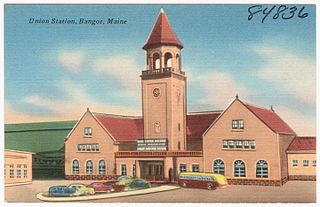
Bangor Union Station was a passenger train station in Bangor, Maine. Long the state's second-largest railroad station, it was served by the Maine Central Railroad and the Bangor and Aroostook Railroad. In 1961, the railroads ended service to the station, which was then demolished to avoid an annual property tax of $10,788 on an assessed valuation of $372,000.

Lee Hall Depot is a historic train station and museum located in the Lee Hall neighborhood of Newport News, Virginia. It was built in about 1881, with a one-story cargo bay, and the two-story main section was added in 1893. Another one-story wing was added by the Chesapeake and Ohio Railway to the north end of the depot in 1918 to handle an influx of military personnel to Fort Eustis. The building is currently in use as a local history museum, focusing on the station's history, and the history of the Chesapeake & Ohio Railroad in Warwick County.

The Market Square Historic District of Houlton, Maine encompasses that town's historic late-19th century central business district. Centered on the junction of Market Square, Court Street, Water Street, and Main Street, it includes a relatively cohesive assortment of brick and masonry commercial buildings, designed by architects and built between 1885 and 1910, following the arrival of the Bangor and Aroostook Railroad. The district was listed on the National Register of Historic Places in 1980.

















